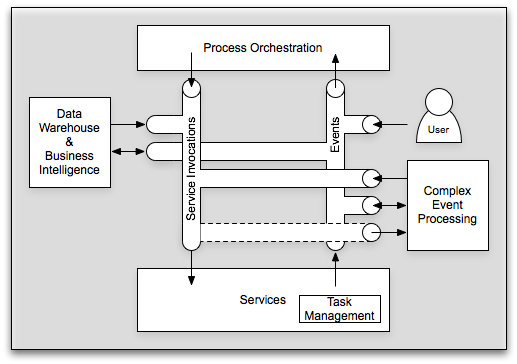 Acronym Soup
Acronym Soup
The panel discussion I was involved with at The Open Group Enterprise Architecture Practitioner’s Conference went very well, at least in my opinion. We (myself, our moderator Dana Gardner, Beth Gold-Bernstein, Tony Baer, and Eric Knorr) covered a range of questions on the future of SOA, such as when will we know we’re there, will we still be discussing it 5 years from now or will it be subsumed by EA as a whole, etc.
In our preparations for the panel, one of the topics that was thrown out there was how SOA will play with BPM, EDA, BI, etc. I should point out that our prep call only set the basic framework of what would be discussed, we didn’t script anything. It was quite difficult biting my tongue on the prep call as I wanted to jump right into the debate. Anyway, because it didn’t get the depth of discussion that I was expecting, I thought I’d post some of my thoughts here.
I’ve previously posted on the integration between SOA, BPM, Workflow, and EDA, or probably better stated, services, processes, and events. There are people who will argue that EDA is simply part of SOA, I’m not one of them, but that’s not a debate I’m looking to have here. It’s hard to argue that there are natural connections between services, processes, and events. I just recently posted on BI and SOA. So, it’s time to try to bring all of these together. Let’s start with a picture:

In its simplest form, I still like to begin with the three critical components: processes, services, and events. Services are explicitly invoked by sending a service invocation message. Processes are orchestrated through a sequence of events, whether human-generated or machine generated. Services can return responses, which in essence are a “special” event directed solely at the requestor, or they can publish events available for general listening. So, we’ve covered SOA, BPM, EDA, and workflow. To bring in the world of EDW (Enterprise Data Warehouse), BI (Business Intelligence), CEP (Complex Event Processing), and even BAM (Business Activity Monitoring, although not shown on the diagram), the key is using these messages for purposes other than which they were intended. CEP looks at all messages and is able to provide a mechanism for the creation of new events or service invocations based upon an analysis of the message flow. Likewise, take these same messages and let them flow into your data warehouse and allow your business intelligence to perform some complicated analytics on them. You can almost view CEP as a sort of analytical engine operating on a small window, while business intelligence can act as the analytical engine operating on a large window. Just with CEP, your EDW and BI system can (in addition to report) generate events and/or service invocations. Simply put, all of the technologies associated with all of these acronyms need to come together in a holistic vision. At the conference, Joe Hill from EDS pointed out that when many of these technologies solved 95% of the problem they were brought in for. Unfortunately, when your problem space is broadened to where it all needs to integrate, the laws of multiplication no longer apply. That is, if you have two solutions that solved 95% of their respective problems, they don’t solve 0.95 * 0.95 = 90.25% of the combined problem. Odds are that combined problem falls into the 5% that neither of them solved on their own.
It is the responsibility of enterprise architecture to start taking the broader perspective on these items. The bulk of the projects today are still going to be attacking point problems. While those still need to be solved, we need to ensure that these things fit into a broader context. I’m willing to bet that most service developers have never given thought to whether the service messages could be incorporated into a data warehouse. It’s just as unlikely that they’re publishing events and exposing some potentially useful information for other systems, even where their particular solution didn’t require any events. So, to answer the question of whether SOA will be a term we use 5 years from now, I certainly hope we’re still using it, however, I hope that it’s not still as some standalone initiative distinct from other enterprise-scoped efforts. It all does need to fall under the umbrella of enterprise architecture, but that doesn’t mean that the EA still doesn’t need to be talking about services, events, processes, etc.
Update: I redid the picture to make it clearer (hopefully).

[…] His blog posting on “acronym soup” is worth a read. […]
Great post Todd – just a quick question: are you missing a line from DW/BI to Events? Or does the line from DW/BI to Process Orchestration imply that an Event has been published?
Thanks Tom. The line entering process orchestration is meant to indicate that the DW/BI system is a source of events. As always is the case, I had too many lines to try to interconnect. 🙂
I redid the picture, hopefully it’s clearer now.
[…] It’s been an interesting week as we’ve had a chance to dialog with enterprise architects and the BPM community at back-to-back conferences presented by The Open Group and OMG, respectively. And as we hinted during our last posting, where we conversed live via blog (and later on stage) with Dana Gardner, Todd Biske, Beth Gold-Bernstein, and Eric Knorr from the Open Group EA Practitioner’s Conference, was how isolated SOA developers appear to be from both groups. […]